|
FAQs about Caryophyllid Coral Predators, Pests
Related Articles:
Coral Pests and
Disease; pests, predators, diseases and conditions by Sara
Mavinkurve, Caryophyllid
Corals, Elegance
Coral,
FAQs on Euphylliid Disease:
Caryophyllid Disease 1, Caryophyllid Disease 2, Caryophyllid Disease 3, Caryophyllid Disease 4, Caryophyllid Disease 5, Caryophyllid Disease 6, Caryophyllid Disease 7, Euphylliid Health 8, Euphylliid Health 9, Euphylliid Health 10,
Euphylliid
Health 11, Euphylliid Health 12,
Euphylliid Health 13,
Euphylliid Health 14,
& Elegance Coral Disease/Pests,
FAQs on Euphylliid Disease by Category:
Diagnosing,
Environmental (Pollution/Poisoning, Lighting...),
Nutritional, Social (Allelopathy),
Trauma,
Pathogenic (Infectious, Parasitic, Viral)
Treatments
FAQs on Stony Coral Disease: Stony Coral Disease 1, Stony Coral Disease 2, Stony Coral Disease 3, Stony Coral Disease 4, Stony Coral Disease 5, Stony Coral Disease 6, Stony Coral Disease 7, Stony Coral Disease 8, Stony Coral Disease 9, Stony Coral Disease 10, Stony Coral Disease 11, Stony Coral Disease
12, Stony Coral Disease 13,
Stony Coral Disease 14,
Stony Coral Disease 15, Stony Coral
Disease ,
FAQs on Stony Coral Disease by Category: Diagnosing:
Environmental (Pollution/Poisoning, Lighting...),
Nutritional, Social (Allelopathy),
Trauma,
Pathogenic (Infectious, Parasitic, Viral)
Predatory/Pest,
Treatments
FAQs on Stony Coral Disease by Family: Acroporid Disease, Acroporid Disease 2, Acroporid Disease 3, Acroporid Disease 4...,
Caryophyllid Disease 2..., Elegance Coral Disease/Pests, Dendrophylliid Disease, Faviid Disease, Faviid Disease 2, Fungiid Disease, Mussid Disease, Mussid Health 2, Poritid Health, Trachyphylliid Disease, Trachyphyllia Disease 2,
FAQs on Stony Coral Disease by Type: Brown Jelly Disease, RTN,
|
Worms, crustaceans, snails... That can and should be
excluded via isolation, aka quarantine on arrival
MANY other Cnidarian groups, species: Anemones of all
kinds, Zoanthids, Corallimorpharians... other Scleractinians... That
should be co-introduced via mixing of waters AFTER determination of
health in quarantine twixt the main and isolation systems.
|
|
Mystery hitchhikers on my frogspawn
2/10/17
Hello WWM crew!
<Kevin>
I was referred here from Bayou Reef keepers by Jordan Stari.
<Ahh! Hi to Jordan. Hope to catch up with him at this year's MACNA there>
He recommended that I post this query specifically directed toward Lynn Z
since she’s the invert expert. I have a mystery beastie on the base of two
of my branching frogspawn heads. When they first showed up, they were so
small I could barely tell they were something other than part of the coral.
Then I started noticing they had kind of a corkscrew antennae or
some other protrusion. I thought they might be some kind of
Nudibranch, but even with a magnifying glass, it was difficult to pick out
any distinguishing characteristics. I searched every site and message board
I could find to no avail. They are right at the boundary between the soft
tissue and the skeleton of each head and seem to retract into the soft
tissue if I shine a light on them for more than a few seconds. When I got
home from work today, one of them had come out far enough that it was ~1/2 –
3/4” long. I took some pictures, but only one of them is small enough in
file size to comply with WWM picture requirements and it is hard to see
anything on that one. I have attached it as a first look. If it’s okay, I
would like to post the best quality picture that shows it pretty well.
Please let me know if that is ok.
<Yes; though; I don't see what you're referring to. Lynn?>
I have had these corals for about two months and they have grown probably
2-3 times the size they were when I got
them in that time. Two of the heads have begun to split. Until about 4 days
ago, all seemed to be well. All of the corals in the tank have been given a
10 minute CoralRx Pro dip before being placed in the tank. I’m thinking that
since they emerged from within the soft tissue, maybe they were there from
the beginning and survived the dip.
In the pic, the dark vertical shape on the left is the branch of the
skeleton. The offending beastie is the whitish thing running parallel to the
branch (it is roughly ½-3/4” in length). As I said, I have better pics, but
did not want to run afoul of the posting rules.
<Do post elsewhere on the Net and send along links please>
Please let me know if you know what this is, whether I should worry about
it, and how I can get rid of it if necessary.
<Like grading school papers, "When in doubt, count it out", I'd vacuum,
remove this>
Thanks in advance for the help!
Kevin Drane
<Have sent on to LynnZ for her input. Bob Fenner>
|
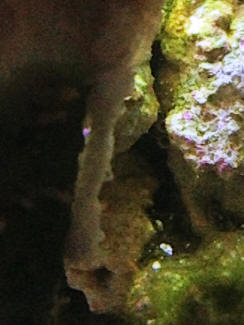
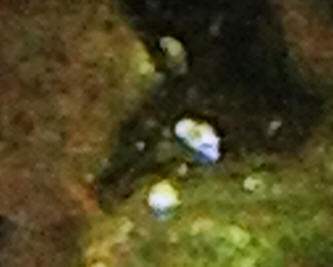 crop...
crop...
|
Re: Mystery hitchhikers on my frogspawn - 2/11/2017
Thanks for the quick response. I have a couple of pics posted on the Bayou
Reefkeeping forum. Here's a link:
Euphyllia eating Nudis?
<http://www.bayoureefkeeping.com/forums/topic/16109-euphyllia-eating-nudis/#comment-191958>
<Mmm; the little white bits right? I don't see rhinophores, gills on these...
Look more like Scutus... a snail on what little I make out... white shells
(could be overgrown), and black feet... No way for you to remove, shoot and send
a better close up pic?>
It seems to be hiding within the soft tissue of the coral because there are
times when you can't see it at all and then it just appears. Thanks again for
the help!
<The better pic please. Bob Fenner>
|
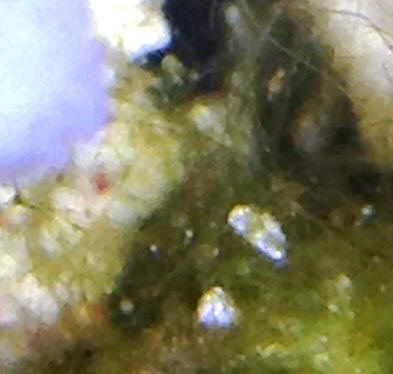 |
|
Re: Mystery hitchhikers on my frogspawn - 2/11/2017
Actually, the long white thing that is extending down from the base of the soft
tissue is one organism. The white bits are part of it.
<Don't see it mate>
There is no shell and it's all white. While it was extended out like that last
night, I tried to suck it out with a turkey baster and it held fast. I then
tried grab it with some tweezers and it still wouldn't come loose. It ended up
breaking in two. The part that was still attached retracted up into the coral's
soft tissue and I haven't seen it since. The part that broke off
kind of fell apart and the pieces were very small helical bits maybe 2-3 mm
long. My fire fish ate ended up eating the pieces. Now I'm worried that it is
going to die inside the soft tissue and as it rots will poison the coral. I'm
debating whether I want to break the heads free from the rock and dipping them
with Bayer.
<Have you considered fragging this colony? I might. B>
Re: Mystery hitchhikers on my frogspawn - 2/11/2017
Thanks for the quick response.
<<Hi Kevin and Bob. Sorry I’m a late arrival on this topic!>>
I have a couple of pics posted on the Bayou Reefkeeping forum. Here's a link:
Euphyllia eating Nudis?
http://www.bayoureefkeeping.com/forums/topic/16109-euphyllia-eating-nudis/#comment-191958
<Mmm; the little white bits right? I don't see rhinophores, gills on these...
Look more like Scutus... a snail on what little I make out...white shells (could
be overgrown), and black feet... No way for you to remove, shoot and send a
better close up pic?>
<<Unfortunately, I can’t see enough detail in the photos to determine exactly
what the subject is either. Offhand, it looks like a typical looping mass of
Cerith snail eggs - I’ve seen these before on Euphyllids. Please see the
following link for an example (bear in mind that these looping masses can be
variably arranged): http://www.nano-reef.com/topic/270550-whats-on-my-frogspawn/
. Do you have any of these snails in your system? If so, and this is an egg
mass, the multitude of loops should start breaking up and detaching within a few
days.>>
It seems to be hiding within the soft tissue of the coral because there are
times when you can't see it at all and then it just appears.
<<If this is an egg mass, perhaps it’s acting as an irritant? Honestly, I’m not
a coral expert so I’m not sure if it’s possible for the soft tissue on a
euphyllid’s stalk to react by trying to alternately envelop then repel an
irritant.>>
Thanks again for the help!
<The better pic please. Bob Fenner>
<<You’re very welcome. I just wish I could have given you a concrete answer.
Ditto what Bob said regarding a photo (if possible!). Take care, Lynn Zurik>>
<Thank you Lynn. B>
Re: Mystery hitchhikers on my frogspawn: Mesenterial Filaments -
2/11/2017
<Greetings, Kevin>
I do not have any Cerith snails
<There goes that theory! On the plus-side, I believe I have an answer for you.>
and I've never seen snail eggs move around like this.
<No, any movement would have to have been caused by something else: water
current, hatching individuals, instability/movement of whatever the mass was
deposited upon, or perhaps a critter of some sort wriggling about inside the
mass.>
Unfortunately, I can't get another picture because after I tried to pull
it off, it retracted back up into the soft tissue of the coral.
<Yep, this is normal (see below).>
There is no question in my mind that it is some kind of separate organism. I
have posted another picture to the forum- this time with annotation.
<Yes, I see – thanks. After thinking about this a bit more this morning, I
started wondering if what we were seeing was simply part of the coral itself,
and that was the ticket. All those loopy structures (that look like guts) did
indeed come from inside the coral. They’re mesenterial filaments
that, thanks to stinging cells/nematocysts, are used to capture/digest, as well
as fight off any threat/intrusion into a coral’s “space”. It could be that the
coral detected a threat (physical or chemical), and deployed the filaments. I
see a small collection of vermetid gastropods to the left of the filaments that
may be at least part of the issue. Vermetids send out sticky strands to catch
food particles that drift by. Those strands could be contacting the coral’s soft
tissue and irritating it. I ran across a photo at WWM that looks very similar:
http://www.wetwebmedia.com/carydisf7.htm . Please see the query at
the bottom of the page titled “Worm infestation… no -12/28/2007”, as well as a
WWM search for mesenterial filaments, Vermetids.>
I appreciate the time you have spent trying to help me.
<No problem, I hope this helps. By the way, if you decide to get rid of the
Vermetids, you can do so my either breaking them off with tweezers at the base
(do not use bare hands – the tubes are brittle and very sharp!), or seal the
tube openings with some gel-type Cyano glue.>
Hopefully the new picture will help you see it better.
<I think we’re good to go! Take care, Lynn Zurik>
Thank you Lynn. B <Always a pleasure, Bob!>
Follow-up Re: Mystery hitchhikers on my frogspawn: Mesenterial Filaments -
2/11/2017
Awesome! Thanks for the diagnosis.
<You are most welcome.>
Jordan was right that you know your stuff.
<Well, we all learned something this time! All I knew was that things weren’t
adding up, critter-wise, so I followed a hunch and it paid off.>
You just saved the coral from the trauma of being broken off the rock and dipped
again.
<Good>
I just knew it was some kind of parasite.
<I can certainly understand why.>
Unfortunately, in my haste to keep a parasite from harming my coral, I tore some
of its mesentery trying to remove it. Hopefully it recovers!
<I would think so.>
It all makes perfect sense now that I put all the pieces together. They had
(very small) Vermetids on them when I bought them as frags. The coral and the
Vermetids have both grown considerably since I got them.
<Yay, regarding the coral! As for the Vermetids, they thrive/multiply in high
nutrient conditions so do keep an eye on this. Same goes for what appears to be
some Spionid or Chaetopterid worms to the right of the mesenterial filaments. In
silhouette, you can see a number of paired feeding tentacles (“palps”). Although
not visible in the photo, these palps extend from hardened mucus tubes covered
with sand grains, bits of substrate, and/or shell. These worms are typically
harmless/beneficial particulate feeders/detritivores but when numerous can
irritate corals, particularly Zoanthids.>
In the last couple weeks, the coral has not been extending as much as it had
been. Now I realize it was due to the Vermetids growing as much as they have. I
will try scraping them off now that I know they are causing irritation.
<Good idea. Just be careful. You do not want to get a nasty infection after
cutting yourself on those sharp little shells!>
Thanks again!
<It was a pleasure! Take care, Lynn Zurik>
|
|
|
yellow mesh starfish; Euphyllia pred. follow-up
8/7/15
i think i have found who has been eating my hammer head and frogspawn.. i can be
wrong but i think not. can you confirm my suspicions?. it looks like a piece of
hammer head coral dangling from the starfish.
<I agree...
Thanks
Vasilios
<Don't see references pointing to Nardoa novaecaledoniae feeding on corals in
the literature though.
Bob Fenner>
Re: yellow mesh starfish 8/7/15
i was told they are reef safe but this shows different. i am going to isolate
him and see what happens. thanks for the quick response. i truly appreciate it
also your knowledge.
Vasilios
<Thank you for sharing. BobF>
|
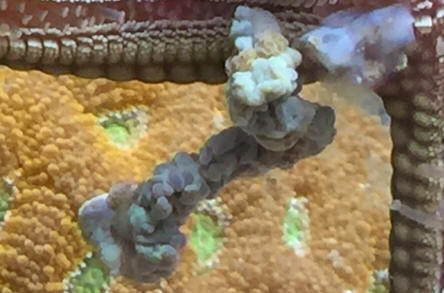 crop
crop |
white bugs on Euphyllia
1/2/14
Hi Bob,
I have been trying to search information on your site about white “bugs”
that seem to specifically infest Euphyllia species, but haven’t found
anything.
<Any chance of a decent pic?>
A Google search has found a few threads from various aquarists and
there’s disagreement on whether they are harmful or not.
<Well; the planet does "show", "exhibit" may be better, all range,
degrees of commensalism, predation et al. relations twixt species,
individuals>
Some say that they disappeared on their own, others say they killed
their corals.
<I can believe/imagine all>
They are not the “typical” copepods that tanks typically have visible on
the glass, and are too small for me to capture on my camera (I tried),
<Maybe a friend has a cheapy scope... there are some really spiffy ones
you can order for cheap that will allow imaging to be recorded>
but this link shows a decent picture of them
http://www.ultimatereef.net/forums/showthread.php?t=473550 .
<Uhh, look like little white zots... could be most anything...>
I have two paradivisas, one ancora and one glabrescens. I mostly see
these bugs on the Torch, though I wouldn’t say it’s being swarmed or
anything. They are not very active, some crawl slowly, some seem to be
partly imbedded into the coral...perhaps feeding on the coral?!
<... what would Doug Adams say/write? "Don't panic">
I have seen the odd one on the divisas, never the ancora. All corals seem
well with the exception of the Torch, which has been slowly receding
over several months. Not sure if the recession is related, as I have had
some recession issues with some other LPS species which do not show any
kind of “bugs”...so I’m not sure if there’s a cause and effect here, or
purely coincidence. Are you familiar with these critters, and can you
tell me whether they are a problem and should be treated somehow, or
harmless?
Thanks,
Dave
<... Are you in China? If the US, UK, I'd go w/ not guilty till proven
so... BobF>
Re: white bugs on Euphyllia 1/3/14
Hi Bob! I'm in Toronto, Canada, so I will assume not guilty until proven
otherwise. Interestingly some hobbyists wrote that they treated with dog
heart worm medication to kill them, and their Euphyllias rebounded and
started looking better.
<This might (well) not be a cause-effect event. Beware of anecdotal
accounts>
They're simply too small to get a good photo with my current camera, and
I don't have access to a scope...there are other photos on line and even
a video on YouTube that someone made to show them, but in all cases they
just look like white dots. I had noticed them for months before
realizing they crawled and were thus alive. For now I will just continue
to monitor. Thanks again. Dave
<Such small critters tend to come and go in captive systems. I would not
over-react. Cheers, BobF>
|
Frogspawn ID and compatibility 4/3/12
Hi crew!
<Hello Jennifer>
I bought a frogspawn about 6 weeks ago. After QT it went into the
main tank. All was good (attached pic) then all of the sudden it
closed up and has not opened back up (attached pic). This has
been going on for about 2 weeks. All of my other corals are doing
well. I was advised that it could be the coral beauty picking on
it so I put it in the refugium hoping it could recover but to no
avail. Water parameters: Ammonia - 0, Nitrite - 0, Nitrate -0,
Phosphate 0,
<Corals do benefit from the presence of low nitrate and
phosphate levels.>
Calcium 420 (a little high, don't know why),
<How about magnesium, equally important.>
pH 8 in am, 8.3 in p.m., salinity 1.024. My question is could
this be coral warfare? The other inhabitants are: Pulsing Xenia
which was introduced into the tank about a week after the
frogspawn, 2 ricordae <Ricordea> mushrooms, and green star
polyps. I have a 55 gallon with a 30 gal refugium, 60 lbs of live
rock and run protein skimmer full time.
Should I put this guy in a hospital tank and see if it is the
other corals affecting it?
<Actually, the Frogspawn is the most aggressive coral amongst
your corals. The star polyps (Briareum) are rather peaceful while
the Ricordea is semi-aggressive. Have you actually witnessed the
Coral Beauty picking on the Frogspawn? My other concern would be
light. You made no mention of lighting and Frogspawn (Euphyllia
paradivisa) appreciate bright indirect lighting. Good water flow,
preferably wavemaker style, also encourages polyp extension.
Euphyllids are good indicators of water quality and failure to
open may indicate less than perfect water conditions. Good water
parameters are not necessarily indicative of good water quality.
If not already doing so, I suggest dosing with iodine/dide. Other
necessary elements such as strontium may be missing as well.
Weekly water changes will supplement these elements back into the
system. Do read here and related articles/FAQs found in the
header.
http://www.wetwebmedia.com/caryophyllids.htm>
Thank you once again!!!
<You're welcome. James (Salty Dog)>
Jennifer
|
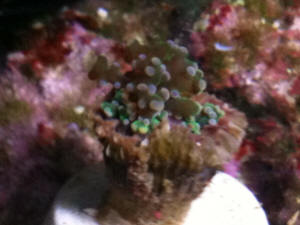 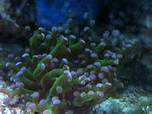 |
|
Re Frogspawn ID and compatibility
4/4/12
Hi James!
<Hello Jennifer>
I don't have a magnesium test kit but I've ordered one
online, should be here soon.
<Good!>
I do weekly water changes about 12 gallons a week.
<Great.>
I have a new AquaticLife Quad T5 running UV <UVL?> bulbs, 2
actinic and (2) 10,000k. I had located the frogspawn to a little
alcove if you will but it was getting a fair amount of water
flow.
<With your lighting you could place the Frogspawn most
anywhere. Actinics offer some benefit but you would be much
better off with three 10K lamps. I am assuming you are using the
UVL Aquasun or Actinic White lamps. Both of these lamps more
closely duplicate the wavelengths corals best respond to. See
attached chart.>
I have 2 Koralia 750 and 2 Koralia 550. I did adjust the water
pumps thinking that might have been the problem and eventually I
did move the frogspawn to a different location in the tank (but
still in the sand) thinking that lighting could have been the
problem and it didn't seem to help at all.
I have not seen the coral beauty nipping at the frogspawn.
He's fairly well behaved when it comes to the corals. I do
put a drop of Lugol's iodine about every 2 weeks.
<I would do three drops every week.>
If it could be water conditions why are my other corals doing so
well?
<Likely because Euphylliids are more sensitive to water
quality than most corals.>
Should I take this coral back to the LFS?
<May want to run some good quality carbon in the system first
and see if there is any improvement before returning the coral.
Which brand of salt are you using?
I have had good results using Tropic Marin. The new improved Red
Sea Salt is pretty good as well.>
Thank you again!
<You're welcome. James (Salty Dog)>
Jennifer
Re Frogspawn ID and compatibility 4/4/12
Hello again James!
<Jennifer>
Yes I am running the UVL Aquasun bulbs.
<That particular lamp closely matches the desired PUR
wavelength that corals respond best to.>
I will seriously consider getting a third Aquasun bulb. I'm
wanting to get more into corals so I want to be sure to have the
proper lighting first.
<May even consider four Aquasun lamps. Would be much better
and increase PAR value.>
I will increase the Lugol's. I do run activated carbon but I
will change it out. I've been using Instant
Ocean but I've been worried about the quality lately. I check
the pH about a day or so after mixing and it's only at 8.0.
My RO water is 7.7.
<I got away from that brand a couple of years ago. Too much
inconsistency in their mix.>
Also after I mix it there is like this brown foamy scum on the
top.
<Wouldn't be from the salt. Do you clean the mixing
container good after use. May be dust getting in the container if
left open.>
I've been researching changing the brand but I'm
concerned about conversion problems.
<Changing 10 gallons of water with a different brand salt
every week should cause no problems.
I've been through this a couple of times in the last five
years.>
I know I've seen an article on your website on how to change
over the salt mix. Thanks
again James!
<You're welcome. James (Salty Dog)>
Jennifer
Re Frogspawn ID and compatibility 4/3/12
Hello Mr. Dog!
<Hello Jennifer.>
Really...4 Aquasun bulbs..cool!
<Would be your best option for a four lamp fixture.>
I've read lighting FAQs and everyone seems to run actinics.
But if the corals can live without them so can I.
<The actinic wavelength is present in these lamps. You
don't notice it as much because it is masked by the other
wavelengths.>
I'm assuming this will also increase the coral options as
well once I get this situation under control.
<It will increase your intensity in the PUR
wavelengths.>
I do wash out the container maybe every 2 or 3 months. The scum
doesn't show up until I mix in the salt and I only take off
the lid on the day I am doing a water change. The container I
keep the top off water in does not get this brown scum in it. So
which brand, Tropic Marin or Red Sea, do you recommend?
<I've been happy with Tropic Marin. It's a bit pricey
but you get what you pay for. It does contain every element found
in sea water.>
Thanks again, James!
<You're welcome. James (Salty Dog)>
Jennifer
Re Frogspawn ID and compatibility 4/4/12
Hello again!
<Hi Jennifer>
Jeesh you are fast!
<Fastest gun east of Tucson.>
Awesome...4 Aquasun bulbs it is! I will start changing over to
Tropic Marin. Thank you for all of your advice!
<You're welcome. James (Salty Dog)>
Jennifer
|
Branching Hammer Coral Problem 1/27/12
Hello Wet Web
Media,
<Wend>
This question pertains to a Euphyllia parancora that I have had
for 5 years.
Purchased with 2 branches, the hammer coral lived 4 years in a 65
gallon reef tank. The hammer moved into a 150 gallon reef tank a
year ago and now has 20+ branches. I have had no major problems.
All corals are growing.
A few months ago, I noticed the tissue which grows on the stony
branches getting darker on one of the 2 original branches.
<I see this>
This darker tissue is spreading to cover up a few of the polyps
and is spreading down the live rock. Please look closing at photo
(photo on its side taken at night so you can see under polyps)
and note the brown tissue spreading down the rock and covering
the lower part of the coral. Is this the dreaded brown jelly
disease?
<Mmm, maybe>
Yikes! If so, I should remove live rock it is now attached to
and
then remove the affected branches...
<I'd leave in place... check all parameters, dose
full-strength w/
iodide-ate. IF the colony continues to disimprove, I would move
it to
another system>
150 gallon reef tank
30 gallon sump
Aqua C skimmer
15 gallon refugium (plan on doubling size soon)
3 power heads
Orphek LEDs
10% saltwater changes each week faithfully
81F stable temperature
1.025 specific gravity
440 calcium (working on this)
<Magnesium?>
Alkalinity between 9-11 (working stability)
Nitrates 0
Euphyllia paradivisa
Euphyllia divisa (huge and directly above the paradivisa)
<Could be this is poisoning the E. parancora>
Green Corallimorphs
<Or these>
Sarcophyton
<Or this>
Sinularia
Fungia paumotensis
Caulastrea Furcata
Cynarina Lacrymalis
Zoanthids
Montipora Capricornis
Seriatopora hystrix
Clove Polyps
Favites
Lobophyllia
Derasa clam
Crocea clams
Red Legged Hermits (will these prey on snails for food?) <Can,
yes>
Blue Legged Hermits
Banggai Cardinal Pair
Shrimp Goby
Red Sea Sail Fin Tang
Ocellaris Clownfish Pair
PJ Cardinal
Chromis
Brittle Star (very large, will this prey on dragonets?)
<Perhaps>
Serpent Star
Thank you so much!
Wendy
<Welcome. Bob Fenner>
|
|
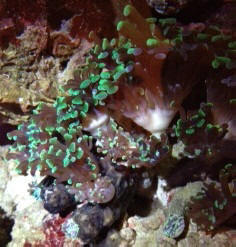
Re: Branching Hammer Coral Problem-encrusting dark
sponge? 1/28/12
Hi Bob,
Thank you for the advice. However, I just couldn't wait it
out...so I dismantled the whole tank to remove the afflicted live
rock and hammer coral. The live rock went into a bucket and I
drove to the LFS with the dark tissue encrusted hammer. I learned
that the dark tissue was not slimy (as I imagined brown jelly to
be), but sponge like. The dark tissue peeled off like the skin of
an orange and had no smell. It must be some sort of encrusting
sponge. ?
<Mmm, maybe... do you have a microscope? Don't know how
much detail we'd expect to see>
I peeled, scrubbed with a toothbrush, discarded the dead branches
of the hammer, fragmented the good branches and soaked them in
Lugo. The newly fragmented hammer branches are relocated in a
high current area where I can retrieve and scrub if/when the
sponge returns. All the polyps are extended and look good.
Sincerely,
Wendy
<And you, BobF>
|
|
Critter ID'¦Barnacle,
Maybe -- 11/04/10
Hi Crew,
<<Samuel>>
I don't have a picture yet and am not sure if I can get one. I just
bought a torch (Euphyllia) and there is something strange in middle of
the tentacles. It is bullet shaped, white, very thin, about 3/16th of
an inch wide and tall. When it opens a little spring like thing comes
out and in. That is best as I can describe it. Maybe an alien space
ship. Doesn't look like a living thing, looks more mechanical.
<<A barnacle perhaps'¦have a read here: http://www.wetwebmedia.com/cirripediafaqs.htm
>>
Thanks
<<Welcome'¦ EricR>>
Re: Critter ID'¦Barnacle, Maybe -
11/05/10
Right on, it really is neat to watch but I think I will get rid of
it.
<<Not likely necessary'¦ Harmless if not beneficial --
and not destined to survive long-term in home aquaria.
EricR>>
Unusual Frogspawn disease or parasite
10/14/10
Hi There,
<Hello!>
I have 2 huge frogspawn corals in my tank for at about 2 years.
Recently both corals started doing poorly. I noticed a bunch of very
tiny "creatures" crawling near the mouth of most of the
coral's heads. So I
remove the corals and bathed them in "Revive" first, then
"Lugol's". I still see the tiny creatures walking around!
What should I do next?
<Mmm, you need to have a positive identification to at least the
phylum level... worm/flatworm, crustacean here, before
proceeding>
Should I use another chemical, if so which one?
<... depends on what this issue is caused by>
Also is there a fresh water dip for corals please? If so how, long
should I deep the corals in fresh water and how often please? Do you
think that would kill them?
I have never seen such "creatures" on any of my corals before
and they only like to live on the frogspawn, all the other corals such
as the hammerhead, sunny corals, colt, polyps, etc... are happy and
have no bugs crawling on them.
Thank you so much for your help.
Fatima
<Well, you can use the search tool on WWM re... or just read through
here:
http://wetwebmedia.com/cardisf6.htm
and the linked files in the series (above). Bob Fenner>
Removing Bristle Worm From Bubble Coral 7/8/09
Hi,
<Hello from Key Largo!>
I have a bubble coral that I purchased 10 months ago. It was injured
and only had a few bubbles on it when I bought it (they said it had a
50/50 chance).
<Impressive you've managed to keep it alive this long!>
Anyway I read up about them and started to target feed it.
<This will benefit this coral. I would also recommend you soaking
your food in Selcon as well.>
It started to look better. About two months ago it began to grow a new
skeleton.
<Very good.>
So far so good. Then last night I saw 2 bristle worms poke out from the
skeleton underneath the bubbles. First I was wondering if they are
eating the bubble coral?
<Likely not. Generally bristle worms eating dying/decaying matter,
not living tissues.>
Second, How do I get them out of there without causing damage to the
bubble coral.
<I would likely not remove, you can observe the coral, but even if
you see tissue loss, that does not necessarily indicate that the
bristle worms are doing the damage, more likely they are doing a
beneficial service of removing the damaged tissue.>
Your help would be greatly appreciated. I have a 180 gallon tank with 1
coral banded shrimp, 1 fire shrimp,
<I would add another so they might pair up and the spawn can feed
your tank.>
1 blue hippo,1 kole tang,1 clown, 2 mandarins,1 Flameback angel,1
Foxface, and 1 yellow tang.
<Watch all those tangs!>
Also have many snails and hermits, and 2 feather dusters.
Thanks,
<Welcome!
Mich>
Jeanine
|
Euphyllia Eating Flatworm? Polyclad --
4/30/09
Hi!
<Hi there, Cath!>
I've lost several of my Euphyllia corals in the last couple
of months.
<Uh-oh>
This morning, I've found what I think is a kind of flatworm
on many of my frog, torch and ancora pieces. With a close look
and more attention, I saw that all my Euphyllia are literally
infested by this 'little' (some are up to
½') beast.
<Yikes!>
There are also a lot of yellow eggs around them. Here is, in a
joined piece, a picture of the beast. The shot was not taken by
me, but by a fellow reefer of my area who has the same problem.
What exactly is this flatworm?
<Looks like a Polyclad of some sort to me (see link below for
more info).>
Is there a way to get rid of them?
<Manual/diligent removal of all visible worms/eggs. In
addition, check any and all other corals (and rockwork if
possible) for further evidence and remove any you come across.
I'd also put the corals, one at a time, in small tub or
container with tank water, and using something like a turkey
baster, blast any areas of dead skeleton/rockwork with water to
hopefully dislodge any unseen juveniles.>
I've made a lot of searches and haven't found anything
about it.
<That's understandable. I looked everywhere and only found
a couple of unconfirmed hobbyist reports related to Euphyllids
and suspected Polyclad predation. Furthermore, I was unable to
find any documentation, anywhere, confirming actual predation of
any coral species by these worms at all. That's not to say
that it's not possible however. Apparently, there's a lot
of information still needing to be discovered/revealed regarding
these large worms. The general consensus is that they're all
predatory - consuming various colonial or sessile organisms such
as Tunicates, Bryozoans, bivalves, barnacles, etc, as well as
other small invertebrates such as amphipods, small snails,
Polychaete worms, and even other flatworms. Also, some evidently
feed on algae, especially diatoms, but only as juveniles. The
problem with this situation is that unless you've actually
seen the worms eating live coral tissue, you have to consider
that their presence may be secondary/incidental. Perhaps the
corals are dying due to one or several other reasons -- for
instance environmental issues (water chemistry, chemical
warfare/allelopathy, etc), or due to fish/crabs, etc picking at
them. The culprit could even be another type of flatworm (perhaps
Acoels?) or something else entirely. The Polyclad flatworms could
be there to prey on the real predator(s), or other
incidental/harmless amphipods, etc, that have congregated to
feast on the sudden bloom of algae and/or dying coral tissue.
Admittedly, an infestation level of anything near a damaged coral
doesn't look good, but I'd rule out other possibilities
just to be sure. I have to admit, if I were in your shoes,
I'd likely err on the side of caution and remove as many
Polyclads as I could. Had there been just one or two, I'd
have left it/them, but in the case of many -- bye bye!
I've got some links for you to read through. Here's a
similar situation: FAQ titled 'Euphyllia Health issues /
hitch hiker ID... likely allelopathy, env. 6/9/08', at this
link: http://www.wetwebmedia.com/carydisf7.htm
Allelopathy issues: http://wetwebmedia.com/cnidcomppt3.htm
Flatworms: http://www.wetwebmedia.com/flatworms.htm >
Thank you!
Cath
<You're very welcome! Take care, LynnZ>
|
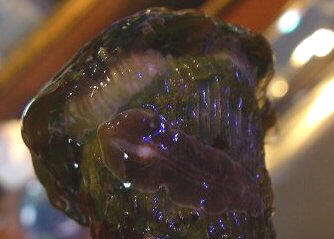 |
Frogspawn Parasite, or just feeding, barnacle
04/02/09
Picked up a Branching Frogspawn from our LFS today, There are four
heads, and directly in between two of the heads is a round piece of
skeleton that sticks out about 1/4 inch farther then the other parts of
the skeleton.
There is a hole on this piece, and periodically, little
"feathers" come out, spin a little bit, then retract.
<This sounds like a barnacle. A picture would be helpful to confirm.
Some can be trouble depending on their location on the coral.>
It kind of looks like a feather duster, but has only a few, (less than
ten) very thin feathers, and they are arranged in a sort of crescent
shape, not even a half circle. They really don't seem to be
affected by light that
much. Is this a parasite, or is it a part of the coral and the way it
eats or something. Thanks for your continued help.
<I don't know if I'd call it a "parasite" per se,
but if it is a barnacle (and if it grows too big in the wrong place) it
can cause some annoyance to the coral. I wouldn't try to remove it
at this point though. Please do try to send a pic.
Cheers,
Sara M.>
Re: Frogspawn Parasite, or just feeding
04/02/09
I have confirmed through pictures online that it is a barnacle, so i
should leave it?
<I would remove it IF it is easy to remove. Try breaking it off with
a pair of needle-nose pliers. If it comes/breaks off easy, good... if
not, I wouldn't go to any extreme measures to remove it.>
If a picture is necessary to tell me if i need to remove it, or to
leave it, i can take a pic tomorrow morning when the lights come on. Do
barnacles pose any threat to the other members of the tank?
<No. I'm not even entirely sure they cause frogspawn any
trouble.
However, I have heard stories (and seen pictures) of barnacles growing
in/on the actual polyps, close to the mouths. Some people swear that a
barnacle growing in such a place has killed their polyps... but I
don't know. I think the barnacles (filter feeders) just grow where
they grow, and sometimes it's inconvenient for a coral.>
we have cleaner shrimp, clownfish, mandarin, hermits, all types of
snails, open brain, lobos, torch, spaghetti leather, mushrooms, Acros,
and pulsating xenias.
<Best,
Sara M.>
|
Vermetid Snail Mucus Causing Frogspawn Polyp Ejection? -
11/14/07 Hello Wet Web Media, Since launching my 24g nano
earlier this year, I have been an avid reader of your site. Thank
you for contributing so much information to the reef-keeping
world. <our pleasure, thank you> Your site has helped me to
diagnose a problem, but now I need input on how, or whether, to
"solve" it. The pride of my tank is a bright florescent
frogspawn that I added about five months ago. Since that time,
two remarkable things have happened: first, the frogspawn has
rapidly divided: from four heads to ten or twelve, and dividing
still. <wow> Loving my frogspawn as I do, I was initially
enthused by its reproduction. I've placed this coral in a
nice space where it can expand and be a real showpiece in the
tank. But I recently read a post by Anthony Calfo on this site
that described polyp ejection (featuring the clear bubble that
has developed on a few of my frogspawn heads as they've
split) as a "stress induced strategy of asexual
reproduction." <Interesting, but I'm not yet
convinced that this is what is happening here with your coral.
There is certainly plenty of reason and academic research to
support the notion that polyp bail out is a response to stress
(and method of asexual reproduction). Polyp bail out is when the
soft tissue of a polyp detaches and drops out of the coral
skeleton. If conditions are right, these dropped polyps will form
new skeleton, and ultimately new colonies. (see "Polyp
Bail-Out: An Escape Response to Environmental Stress and a New
Means of Reproduction in Corals" by Paul W. Sammarco,
published in Marine Ecology, Vol. 10: 57-65, 1982). Thus, if your
corals polyps were bailing out, I'd expect them to be dropped
from the mother colony and forming new colonies (not forming new
branches on the same colony).> This got me thinking about the
second remarkable thing that has happened since I acquired the
frogspawn: in the last several weeks, a great deal of mucus or
webbing has accumulated around the stalk or stem of this coral.
Today, with the help of your site, I at last found the likely
cause of this mucus: the frogspawn came with what I originally
believed to be two tube worms attached, but what I now believe to
be Vermetid snails. A small colony of Vermetids has since grown
up on the frogspawn and the surrounding live rock. (Perhaps they
thrive on the phyto I feed my feather duster.) Recently the web
of Vermetid mucus has grown pretty thick on the frogspawn and has
even trapped a bit of detritus. <Indeed, this is what the webs
are for. If you watch them, you can actually see them
"reeling in" these webs to collect their catch.> So
now I am wondering: could this mucus web be irritating the
frogspawn, resulting in stress-induced asexual reproduction?
<It's *possible* but I'm not sure how likely...> If
so, is that a bad for the long-term health of the coral?
<It's hard to say since I'm still not sure your coral
is truly stressed. Could you send in some pictures maybe?> If
so, what if anything should I do to prevent it? Would you
recommend or advise against an effort to baste or vacuum some of
this mucus off the coral? <Likely a futile effort...the snails
will just make more.> Dare I attempt to remove the snails?
Some sort of dip? <Eek, don't dip it. If you MUST kill the
snails, use a needle/syringe to inject vinegar/Kalk/etc. into the
tubes.> Thank you very much for your time and expertise. Ben
Irvin <De nada, Sara M.>
Attn Sara M: Vermetid Snail Mucus Causing Frogspawn Polyp
Ejection? -11/14/07 Hello Sara, Thank you again for your time and
insight. So, if polyp ejection or bail out results in a complete
detachment of the polyp, that is definitely not what is happening
to my frogspawn. However, some, but not all, of the heads that
have divided on my frogspawn have developed a clear bubble
similar to the one pictured on this page:
http://www.wetwebmedia.com/caryfCorlsaqs.htm And the frogspawn
does seem to be splitting very fast. <Yeah, this is odd...>
Here are two pictures: the first, #546, shows the frogspawn from
below. You can the see largest, green worm-like structure, as
well as a web of greenish-whitish mucus-like material
accumulating on the coral and the rock. <That actually
doesn't look like Vermetid snail mucus web. If anything it
kind of looks like sponge.> The second, #550, shows the
frogspawn from above and behind. You can see more worm-like
structures, as well as a web of mucus-like material that is
catching detritus. This is the first I've noticed, but there
seems to be some algae now growing on the mucus-like material as
well. <That wouldn't happen with Vermetid snail mucus.>
One last thing that perhaps I should have mentioned earlier: this
frogspawn is hosted by two true Percs. <Hmmmm... interesting.
Normally I would tell you that clown hosting is very stressful to
corals. But this is such an odd thing with your coral growing so
fast.> I'll confess, I thought I had it all figured out,
so I await your judgment: is this bad for the coral? need it be
addressed? if so, how? <I'll be honestly with you, I'm
a little baffled myself. Hosting clowns usually stress out corals
quite a bit. But if your coral is growing this fast, and if it
keeps growing this fast, I'd question how stressed it must
be. Typically, stressed corals don't grow so fast (if much at
all). Let me ask you, do the clowns feed the coral?> Thanks
once again. Ben Irvin <Thanks for writing, Sara M.>
Re: Attn Sara M: Vermetid Snail Mucus Causing Frogspawn
Polyp Ejection?-11/14/07 Hi Sara, It's really nice of you
to take the time, and I'm happy to respond, even at risk of
showing my ignorance, so long as I am not taking up too much of
your attention. <Not at all... I quite enjoy hearing from
other people about their experiences with their corals.> I,
too, wondered about the possibility of a sponge, but was at a
loss to explain the worm-like structures in the gauzy, mucusy
material. <I know it doesn't look like your typical
sponge, but I'm 98% sure it's some kind of sponge.
Sponges can be mucus-y, web-like, gauzy... all the things
you're describing are not inconsistent with some kinds of
sponges.> To give you a better sense of what this looks like,
if I saw it growing in my fridge, or in a garbage can, I'd
think that it was mold. It is whitish-greenish in color, it
clings to (possibly grows on) the adjacent rocks. It has
developed worm- or tube-like structures in it. It seems to cling
to, or grow on, the lower, green portion of the stalk rather than
on the white portions of the heads. Now, ugh, here's my
ignorance: in response to your question, do the clowns feed
the coral, my answer is, I don't know what that means. I feed
my clowns Mysis and Cyclopeeze every third day, a reduced feeding
schedule that is aimed at reducing nutrients in the tank. (I also
add a few mg of phyto twice per week.) I occasionally squirt some
of the Cyclopeeze in the general direction the frogspawn, but in
general I don't target feed it. The clowns stay close to the
frogspawn and swim in and around its heads at night. <Just
like how clowns bring food to anemones in which they might be
hosting, they will often also bring food to any coral in which
they are hosting. This is what I mean by "feeding.">
Again, I acquired this coral in May. It had four heads when I
obtained it, and I suspect I'll have sixteen soon
enough, each heading having split and many now splitting again.
<Dear lord that's a lot of splitting. Do you have any
pictures of the whole coral colony? I'm just curious to see
this thing now.> This coral had been fragged off of a specimen
the size of a basketball in my LFS's show tank. So perhaps it
is just a quick grower. <Oh cool... I was just going to say
that it would be interesting to see if the coral grew just as
fast without the clowns (and/or in a different tank). So, if a
frag of it in a different tank is growing just as fast, that
might tell us something. But I'm afraid I still don't
have a real answer for you as to why it's growing so fast. I
suppose it could have some sort of genetic "defect"
that is causing this. But I honestly don't know. Please do
record all this though (take pictures and make notes of
observations).> But I want to be sure that whatever is
growing/clinging to its trunk is not an irritant. <If
you're worried, and if you can easily remove it, go ahead.
Better safe than sorry I suppose.> Your insight is greatly
appreciated. Ben <De nada, Sara M.>
Re: Attn Sara M: Vermetid Snail Mucus Causing Frogspawn
Polyp Ejection? -11/14/07 Hi Sara, Unless you recommend
otherwise, I will put some light water pressure (turkey baster)
on what we think is the sponge. If it blows off, great, but if it
doesn't budge, I probably won't risk any kind of
intervention. <Sounds like a good plan. You could also use a
pair of tweezers to try and gently pull it off if the baster
doesn't work.> Later this evening, I will send you two
pics of the coral, one opened and one closed. <Cool,
thanks!> Have I told you that I appreciate your expertise?
<Hehe, yes, and thank you again for sharing with us.> Ben
<Best, Sara M.>
Re: Attn Sara M: Vermetid Snail Mucus Causing Frogspawn
Polyp Ejection? -11/14/07 Thanks for the advice, Sara. During
a regularly scheduled water change this evening, I attempted
first to suction and later to blow this unidentified material off
the frogspawn. I was able to remove a little of the detritus and
what looked like a bit of brownish hair algae, but the mystery
material stayed put. So, since you haven't identified it as
fatal coral-killing death stuff, I'm going to let it be.
<Yeah, I'd just let it go for now. Most sponges don't
pose any real threat to stony corals.> I've attached two
pix: the first, #556, shows the whole coral as it's
beginning to retract for the evening. For scale, the whole thing
cuts an arc a little bit bigger than a soft ball.
<Thanks for the pics, looks like a healthy coral. :-)> The
second pic, #566, shows the coral closed up a bit. I had hoped
to show you a picture of the coral closed all the way, so
that you could distinguish the separating heads, but the
frogspawn doesn't seem inclined to close up tight tonight.
But, just for example, the two heads at the far right of the
picture have each developed two mouths and the splits seem
imminent. Likewise, on the far left, what appears to be one big
head is actually four. It's really been amazing to watch.
<Indeed, very interesting.> But so long as it is not an
unhealthy response, I'm happy! <Corals are still so
mysterious to us humans. All I can really say is that the coral
looks plenty healthy. I'm not going to promise you that
there's no chance this accelerated splitting isn't a
result of some kind of stress. But I don't have any reason to
say it is either. And even if it were, it's obviously not
killing the coral. So I say just keep doing what you're doing
and keep an eye on it.> (Also, in the background of 566, you
can see a bit of pink sponge in the vicinity, so maybe this is a
sponge-worthy rock.) <LOL... "sponge-worthy"--too
funny.> And speaking of rock, you rock. Thanks for all your
help. If you ever need a totally noobtastic second opinion, be in
touch. <Fabulous, my pleasure.> Best wishes,
Ben Irvin
<Best,
Sara M.>
|
|
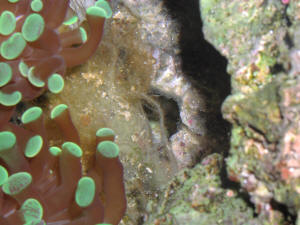 .JPG)
|
Re: Aiptasia and
Frogspawn corals 5/31/06 Hello Bob. The return of the
Aiptasia, imagine that! A strange thing noticed on the specimen growing
among the frogspawn colony: The tentacles closest to the frogspawn
polyps are receded and wilted while the pest tries to avoid these
polyps. I found several others growing near the top of the tank where
the P. skimmer empties into the water. I know why they grow here though
only discovered their presence in the passed couple weeks. This is
where I put food for dispersion by the flowing water and it sometimes
collects near the top of the rock. I purchased what I thought are
Peppermint shrimp but I am not so sure as these are larger than usual
and the coloration seems more subdued and the specimens darker. These
are neat little guys at any rate even if they do happen to be the wrong
shrimp. I am still looking for the Berghia but have never seen one
offered at any of the LFS(s). Right now I am using my QT tank for
control though the one rock is exceptionally large where these pests
reside. I may restart my 55 gallon tank and purchase a Copperband
butterfly or similar species for control... not sure though as
incurring more expenses and maintaining yet another tank might get real
old real fast. Maybe if I can repair the light fixture on the 24 gallon
(I think the external ballast went) then the new light I got could get
moved.... Decisions, decisions.... Sincerely, James Zimmer
<<James: Frogspawn has a powerful
sting. Sounds like it is stronger than the sting of an
Aiptasia. Peppermints are hit or miss. When I
have bought them, only about 1/2 to 2/3 eat
Aiptasia. Berghia are available online. If you do
a search on www.reefcentral.com and other sites you may find people
selling them. Unfortunately, if they work, they will die
once they have eaten all the Aiptasia. Rather than use
critters, if you don't have too many, I like to make a batch of
Kalk paste and inject it into the Aiptasia holes with the plastic
syringe you get with baby medicines. After you inject it,
don't scrape the paste off. Eventually coralline algae
will grow right over it. Best of luck,
Roy>>
Re: Aiptasia and
Frogspawn corals - 06/01/2006 Roy. Thank you for the advice
on Aiptasia control. I have used the Kalk paste or slurry also and
depending on location or orientation to preferred animals I am
sometimes reluctant. Yes, this latest crop will have my work cut for
me. I may just use the paste method again for the large rock as it is
too much to move into the smaller QT. As for smaller rocks I can move
them and train, hopefully, the shrimp to eat the pest anemones. I will
not use concentrated Ca(OH)2 near the frogspawn if I can at all help
it. Again, thank you. James <<James: You're
welcome. Based on my experience, the Peppermint Shrimp will
either like Aiptasia or not (that's why if you have a big enough
tank, it's good to buy 2 to 3 to see who will eat
them). In my best case, one peppermint ate about 100
Aiptasia within about a day. It was amazing to see him
attack them. He looked like a boxer working on a speed
bag. Unfortunately, for that Peppermint Shrimp a Skunk
Cleaner Shrimp attacked him and ate him. I guess the Skunk
Cleaner liked the taste of Aiptasia fed shrimp. If you are careful with
the baby medicine syringe and make a thick enough paste, you can inject
the paste with a lot of control (like you are decorating a
cake). If some of the paste starts to float off, just
disburse it as fast as you can. In my experience, if a
little bit brushes a coral (such as your frogspawn) as it floats buy,
it won't hurt anything. Best of luck, Roy>>
Frogspawn health 4/14/06
Hello
Crew,
<Edward>
Help, my frogspawn hasn't come out since last Fri. It still has
all of its color and doesn't have brown jelly. My water params.
on Sat. were:
pH: 7.9
calc: 390
alk: 8.4 dKH
mag: 1140
sg: 1.025
phos: 0
amm: 0
trite: 0
trate: 0
<These numbers are all okay, but...>
I had several corals that withdrew their polyps for a couple of
days so I checked for everything. I found a leak in my tank and my
top-off worked overtime. My sg went from 1.026 to 1.024 by Thurs.
By Fri. I had my sg back up to 1.025. All the other corals are back
to normal but the frogspawn has not come out at all. I have noticed
the white things circled in the pic and can not figure out what
they are. I can't tell whether it's a worm of some type or
just the tissue folded up on itself.
<... Mmm, these look like a problem to me... perhaps predatory
Nudibranchs...>
Should I dip this coral? Wait it out? Or is it too late?
<Not too late. I definitely would dip this colony. In water of
slightly reduced spg. with a triple dose of Lugol's applied to
it... for fifteen minutes... and I would siphon out these
"worm like" creatures if you see them again>
Any help would be appreciated. Thanks.
<Do read the coverage on the Caryophylliidae posted on WWM. Bob
Fenner> |
|
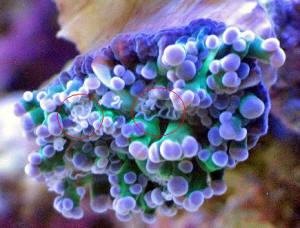
|
Seeking advice for a problem (disease/parasites?)
with my branching hammer coral (Euphyllia parancora)
2/14/06
Hi! I have a beautiful and (so far) healthy branching
hammer coral with metallic green tips. There are even new branches
slowly coming out. I
recently noticed that there were small holes in the skeleton (I mean
the hard non-fleshy part...). Holes have a diameter of about 1mm.
I
verified
with a needle (with caution) to be sure they were not just dark spots
giving the false impression there were holes but they really are holes.
In two
places the holes are much larger (many small holes done next to
another?) making those spots look like a piece of cheese...
<Good description>
The night before I noticed hundreds of small oval shaped 1mm creatures
crawling everywhere in the tank
(glass, LR, and LPS corals). They are not flat, really like tiny little
whitish walking eggs. They don't look like the typical copepod. I
also have
some copepods and really I don't think these are. They walk in a
somehow clumsy way and not in a gastropod's fashion. Sometimes they
just release
hold and let themselves go away with the current. Even tough very small
I think I can see eyes gleaming when I use the flashlight (as with
mysids) so
they could be crustaceans. I took one and tried to see better with a
magnifying glass but I couldn't see more details. Unfortunately I
don't have
access to a microscope right now. I didn't see any of them actually
entering/exiting a hole so I can't even conclude they are related
to the problem.
<Not likely>
Is it even possible that these holes were there since I got the coral
but that I never noticed. I don't think so, but since I didn't
take any
pictures... Of course now comes the paranoia and I am under the
impression that the coral's fleshy base was whiter than it is now.
Looks a bit brownish
to me under the flashlight (it's subtle...).
<This is no worry>
I am worried for my corals, I have other beautiful Euphylliids in the
tank and I don't want to loose them.
<Or lose them>
I know it's probably not an easy question.
Thanks for any advice!
Dominique
<The empty areas are very likely due to your water quality...
Something out of balance... biomineral (calcium, or magnesium
percentage) and alkalinity... check these and fix. Along with feeding,
sufficient light, good care, these should go in time. The
"bugs?"... I'd ignore them for now. Bob Fenner>
|
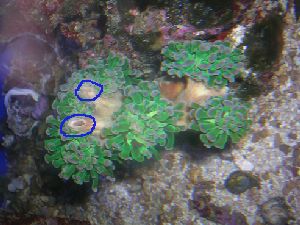
|
Hammer Coral With Feather Worms? - 11/25/05
Hi Bob,
Anthony, crew,
<<Crewmember EricR here tonight.>>
These holes in my hammer coral contain a feather worm of some
type?
<<Are you asking me? I've seen this before in
various corals (usually Porites), though never before in a Hammer
Coral.>>
There is also one hidden in the branch head below in the
middle.
<<ok>>
Sent an earlier email in regard to why my hammer withdraws as the
day goes on. Could these be the culprits?
<<Possibly...most corals show a tolerance for these
worms...but there's always the exception.>>
If so should I eliminate them and how?
<<Up to you... If you think they are causing the
hammer to decline and you wish to keep it over the worms, then yes,
you'll probably have to remove/kill them.>>
Thanks,
Have a Happy Thanksgiving.
Tom
<<Regards, EricR>> |
|
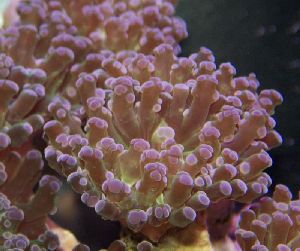
|
| Frogspawn Infestation 11/6/05 Hello all,
<Howdy Matt> WWM is an excellent site with tons of info. I
could not find anything with my problem, however. I have a 45
gallon breeder aquarium with 285 watts of VHO light that is
dedicated to mostly LPS/softies. It has been set up for about 10
months, and most of the livestock is doing very well.
Beginning about 4 weeks ago, the frogspawn was not showing as much
polyp extension. There has been progressively less and less
extension since that time, so I looked very closely at it. There
are many tiny white creatures crawling all over it. From a
macroscopic perspective thy look like copepods: Same tiny size,
white color, and movement. I'm attaching a picture that shows
the relative small size of the critters, if not much definition.
<Nice pic> I also have other Euphyllia in the tank including
a torch coral, hammer coral, and pearl bubble coral. All these
corals are doing well and do not show any signs of infestation.
Tank parameters are kept stable with a top off unit and B-Ionic. I
run an aqua C urchin skimmer and do regular water changes. I have
not dipped new corals when I add them to the tank however, and feel
that this is the most likely source of the white critters. Other
measurements: Salinity 1.025 Nitrates 0 Ph 8.2-8.3 Ca 420 DKh 9.8 I
know I should start dipping new corals, but what can I do for the
current Frogspawn infestation? And what are these things?
Thanks, Matt <From the pic, your description of their behavior,
likely some sort of crustacean... I would go the fish predator
route here if you can allow, have space... Perhaps an Amblygobius
species of Goby... a small, compatible wrasse... Bob
Fenner> |
Melting Xeniids & Flatworms Galore Hi there WWM Crew.
<Hey, Mike G with you tonight> Have been enjoying your site and
links but have run into a couple of problems. To begin, let me give you
the stats on the tank: <I personally thank you for giving me the
stats on your tank. Out of many, many emails I have answered today, you
are the first to provide such information. :-) > SG 1.025
<Fine> pH 8.0 in the morning (before lights come on) and 8.2 5
hours after lights on.. <You might want to find a way to remedy
this. That is a large pH swing, and would cause undue stress to your
pets.> NO2 (0) <Perfect>
NO3 (20) <Okay, but it could be a bit
lower> NH3 (0) <Perfect> Tank is
set up with l MH l4000K and 2 65W 03 actinic along with a Bak Pak 2R
protein skimmer that's skimming l/2 C of green stuff a day. Tank
temp. fluctuates between 77.5 to 80F degrees lately. Water change
weekly 15 gals. Sometimes time doesn't permit, and water gets
changed every 2 weeks. <Sounds fine. I am left wondering how large
your tank is, though.> Problem l: For some reason, my pulsing xenias
are dying (melting) and I can't figure out why. Have had these
Xenias now for almost 2 years pulsing and dividing away and
now... What's going on here? <This is a common problem
with Xeniid corals, they seem to "melt" when in unfavorable
conditions or after drastic changes in water parameters. Take a gander
at the following link, namely the topic "Xenia Health" about
3/4 down the page. http://www.wetwebmedia.com/xeniidfaqs3.htm
> Problem 2: My frog spawn frag (originally only 2 heads - now 6
heads) has been invaded with oval shaped pumpkin colored flatworms -
have no idea where they came from as I do quarantine any and all going
into the main tank. I've read that they come and go But, now
they've migrated to my pagoda coral and I really don't want it
to take over the whole tank (60 gal)! <Ah, there we go, 60
gallons. Flatworms have a habit of overrunning marine aquaria.> On
my next water change or sooner, can I do a fresh water dip or
Lugol's iodine dip on these two corals without harming them and
hopefully getting rid of the flatworms? <That is exactly what
I would have recommended you do.> Thank you for your help/advice.
<Best of luck, Mike G>
|
|

